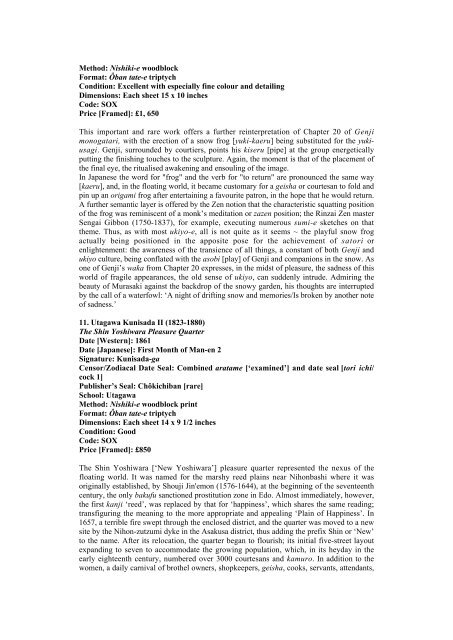You also want an ePaper? Increase the reach of your titles
YUMPU automatically turns print PDFs into web optimized ePapers that Google loves.
Method: Nishiki-e woodblock<br />
Format: Ôban tate-e triptych<br />
Condition: Excellent with especially fine colour and detailing<br />
Dimensions: Each sheet 15 x 10 inches<br />
Code: SOX<br />
Price [Framed]: £1, 650<br />
This important and rare work <strong>of</strong>fers a further reinterpretation <strong>of</strong> Chapter 20 <strong>of</strong> Genji<br />
monogatari, with the erection <strong>of</strong> a snow frog [yuki-kaeru] being substituted for the yukiusagi.<br />
Genji, surrounded by courtiers, points his kiseru [pipe] at the group energetically<br />
putting the finishing touches to the sculpture. Again, the moment is that <strong>of</strong> the placement <strong>of</strong><br />
the final eye, the ritualised awakening and ensouling <strong>of</strong> the image.<br />
In Japanese the word for "frog" and the verb for "to return" are pronounced the same way<br />
[kaeru], and, in the floating world, it became customary for a geisha or courtesan to fold and<br />
pin up an origami frog after entertaining a favourite patron, in the hope that he would return.<br />
A further semantic layer is <strong>of</strong>fered by the Zen notion that the characteristic squatting position<br />
<strong>of</strong> the frog was reminiscent <strong>of</strong> a monk’s meditation or zazen position; the Rinzai Zen master<br />
Sengai Gibbon (1750-1837), for example, executing numerous sumi-e sketches on that<br />
theme. Thus, as with most ukiyo-e, all is not quite as it seems ~ the playful snow frog<br />
actually being positioned in the apposite pose for the achievement <strong>of</strong> satori or<br />
enlightenment: the awareness <strong>of</strong> the transience <strong>of</strong> all things, a constant <strong>of</strong> both Genji and<br />
ukiyo culture, being conflated with the asobi [play] <strong>of</strong> Genji and companions in the snow. As<br />
one <strong>of</strong> Genji’s waka from Chapter 20 expresses, in the midst <strong>of</strong> pleasure, the sadness <strong>of</strong> this<br />
world <strong>of</strong> fragile appearances, the old sense <strong>of</strong> ukiyo, can suddenly intrude. Admiring the<br />
beauty <strong>of</strong> Murasaki against the backdrop <strong>of</strong> the snowy garden, his thoughts are interrupted<br />
by the call <strong>of</strong> a waterfowl: ‘A night <strong>of</strong> drifting snow and memories/Is broken by another note<br />
<strong>of</strong> sadness.’<br />
11. Utagawa Kunisada II (1823-1880)<br />
The Shin Yoshiwara Pleasure Quarter<br />
Date [Western]: 1861<br />
Date [Japanese]: First Month <strong>of</strong> Man-en 2<br />
Signature: Kunisada-ga<br />
Censor/Zodiacal Date Seal: Combined aratame [‘examined’] and date seal [tori ichi/<br />
cock 1]<br />
Publisher’s Seal: Chôkichiban [rare]<br />
School: Utagawa<br />
Method: Nishiki-e woodblock print<br />
Format: Ôban tate-e triptych<br />
Dimensions: Each sheet 14 x 9 1/2 inches<br />
Condition: Good<br />
Code: SOX<br />
Price [Framed]: £850<br />
The Shin Yoshiwara [‘New Yoshiwara’] pleasure quarter represented the nexus <strong>of</strong> the<br />
floating world. It was named for the marshy reed plains near Nihonbashi where it was<br />
originally established, by Shouji Jin'emon (1576-1644), at the beginning <strong>of</strong> the seventeenth<br />
century, the only bakufu sanctioned prostitution zone in Edo. Almost immediately, however,<br />
the first kanji ‘reed’, was replaced by that for ‘happiness’, which shares the same reading;<br />
transfiguring the meaning to the more appropriate and appealing ‘Plain <strong>of</strong> Happiness’. In<br />
1657, a terrible fire swept through the enclosed district, and the quarter was moved to a new<br />
site by the Nihon-zutzumi dyke in the Asakusa district, thus adding the prefix Shin or ‘New’<br />
to the name. After its relocation, the quarter began to flourish; its initial five-street layout<br />
expanding to seven to accommodate the growing population, which, in its heyday in the<br />
early eighteenth century, numbered over 3000 courtesans and kamuro. In addition to the<br />
women, a daily carnival <strong>of</strong> brothel owners, shopkeepers, geisha, cooks, servants, attendants,












